
| Chelonii | ||
| The Vertebrates | Testudinidae |
| Vertebrates Home | Vertebrate | Vertebrate |
|
Abbreviated Dendrogram
Anapsida ?
│
└─○Chelonii
├─Odontochelys
└─┬─Proganochelys
└─┬─Proterochersis
└─┬─Meiolanoidea
└─┬─Pleurodira
├─Paracryptodira
└─┬─Protostegidae
└─┬─Angolachelonia
╘═╤═Xinjiangchelyidae
└─○Centrocryptodira
╞═Sinemydidae
├─Trionychoidea
└─┬─┬─Chelonioidea
│ └─┬─Chelydridae
│ └─Kinosternoidea
└─○Testudinoidea
╞═Lindholmemydidae
└─┬─Emydidae
└─┬─Geoemydidae
└─○Testudinidae
├─Hadrianus
└─┬─○Xerobatinae
│ ├─Manouria
│ └─┬─Stylemys
│ └─┬─Gopherus
│ └─Hesperotestudo
└─○Testudininae
├─Testudinini
└─Megalochelyini
|
Contents
Overview |
Taxa on This Page
In a subsequent portion of this narrative I shall have frequent occasion to mention this species of tortoise. It is found principally, as most of my readers may know, in the group of islands known as the Gallipagos... They are frequently found of an enormous size... They can exist without food for an almost incredible length of time, instances having been known wher they have been thrown into the hold of a vessel and lain two years without nourishment of any kind - being as fat, and, in every respect, in as good order at the expiration of that time as when they were first put in... They are excellent and highly nutritious food, and have, no doubt, been the means of preserving the lives of thousands of seamen employed in the whale-fishery and other pursuits in the Pacific.
--Edgar Allen Poe, The Narrative of Arthur Gordon Pym of Nantucket
For sailors in tropical oceans before the invention of refrigeration, keeping supplies of food was a serious issue. It was a permanent challenge to keep supplies fresh and edible, and indeed, much of the time stores failed at both. Under such conditions, the giant tortoises of the Galapagos islands and the Mascarenes and other islands in the Indian Ocean would have been seen as nothing short of miraculous. Tortoises could be captured easily and kept in the hold of a boat for extended periods without feeding, only slaughtered when they were actually required for eating. As a result, ships that were in a position to do so often took on tortoises in large number, and Charles Darwin apparently recorded single vessels taking up to 700 individuals at a time. By modern standards the idea of seven hundred starving tortoises crammed into a single hull seems unthinkably cruel, but doubtless the sailors who otherwise faced another six months of decomposing ship's biscuit saw things differently.
 |
| Geochelone becki, the Volcano Wolf tortoise.Photo by Joe Flanagan. |
Unfortunately, such intense harvesting took an inevitable toll. Tortoise numbers declined rapidly, and many went extinct. Honneger (1981) lists three extinct species of tortoise from the Galapagos (including Geochelone abingdoni from Pinta island, which only survived in the form of a single captive male) and at least six extinctions from the Seychelles and Mascarenes. Extinct populations on the Galapagos islands of Rabida and Santa Fe may have represented further undescribed species.
However, a paper published in the Proceedings of the National Academy of Sciences adds a remarkable coda to the history of one of the "extinct" species, the Floreana tortoise Geochelone elephantopus. Using DNA extracted from museum specimens collected on Floreana before the population disappeared, Poulakakis et al. (2008) have demonstrated that G. elephantopus may not be quite as extinct as previously thought. Instead, anomalous genetic haplotypes previously identified in some living individuals of Geochelone becki, a species found on the Volcano Wolf at the northern end of Isabela, the largest island in the Galapagos, indicate descent from G. elephantopus. These individuals would appear to be descendants of past hybridisations between native Volcano Wolf tortoises and introduced Floreana tortoises.
Such a situation is quite believable. As a result of the widespread transport of tortoises for food, many tortoises ended up on islands to which they were not native*. Tortoises were regularly imported to Réunion in the Mascarenes after the native population became extinct. Living populations of giant tortoises on the Granitic Islands of the Seychelles probably descend from imports from Aldabra rather than representing the species originally found there (Honegger, 1981). According to Poulakakis et al. (2008), some 40% of the Volcano Wolf tortoises tested showed evidence of Floreana ancestry, so the genetic legacy of Geochelone elephantopus is alive and well, at least in hybrid form.
*Potentially a serious issue for taxonomy, as researchers cannot assume that species names based on inadequate type material necessarily represent the species native to the island the type was collected on. Honegger (1981), for instance, cast doubt on whether Geochelone gouffei, known from a single specimen found on Farquhar Island in the Seychelles, actually originated there.
This still leaves a significant problem - most conservation policies do not cope well with hybrids. A number of species worldwide, such as the black stilt (Himantopus novaezelandiae) in New Zealand, are regarded as endangered because of the risk of hybridisation with related species. The red wolf (Canis rufus) and the Florida panther (Puma concolor coryi) represent two 'endangered' taxa in the United States for which the suggestion that their histories could have been compromised by hybridisation led to the suggestion that they should be abandoned as worthwhile conservation targets. However, the disappearance or decline of a species in its pure form due to hybridisation with another species is a different proposition from its decline due to replacement by that species. The genetic legacy of the declining species may still persist. Overemphasis on species "purity" may actually hinder the conservation of endangered taxa, especially if natural hybrid zones with related taxa exist in the first place (Allendorf et al., 2001). If there are no purebred Florida panthers, should that mean that there is no place for panthers in Florida?
CKT081009
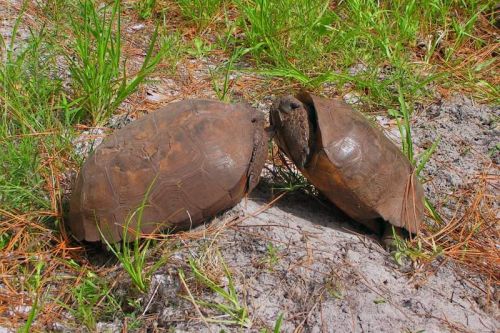 |
| Pair of male gopher tortoises Gopherus polyphemus duking it out, photographed by Daniel Parker. - (via CKT) |
Range: Paleocene to recent, cosmopolitan except Australasia
Phylogeny: Testudinoidae : Echmatemys + (Batagurinae + (Geoemydinae + * : Hadrianus + (Xerobatinae + Testudininae)
Characters: (from Gaffney & Meylan 1988): Two or fewer phalanges in manus and pes; only four digits in pes; quadrate usually enclosing stapes; axillary and inguinal glands absent; slightly wide fissura ethmoidalis; cloacal bursae absent; coracoid blade wide; foramen nervi trigemini with maxillary aperture; trochanters of femur coalesced. (CKT), loss of the longitudinal ridges on the palatines (Gerlach 2001)
Further description: "Skull with open temporal fossae; quadrate closed behind. Shell completely ossified even in the young, more or less ovoid, and covered with epidermal shields. Plastron suturally united with the marginals; an entoplastron present. Sternal bridge long, sternal chambers very slightly developed ; anterior and posterior extremities of hyo- and hypo-plastron little extended inwards; marginals of bridge mth median processes interlocking with rib ends. Skull with open temporal fossae ; quadrate closed behind. Pubic and ischiadic symphyses firmly connected with each other. Limbs with free digits, which are short and moderately elongate ; terminal claws four or five. Second and third digit of pes never with more thou two phalanges. Tertiary and Recent." - Zittel, Eastman, et al (1932) p. 203
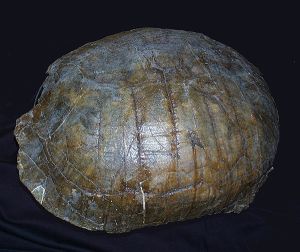 |
| The presumably stem Testudinid Ergilemys insolitus Matthew and Granger, 1923, Carapace, Late Eocene, Ergilin Dzo, Gobi Desert, south-eastern Mongolia, from The Russian Dinosaur Exposition, original url. Also at Mathematical com |
Comments: The Testudinidae or Tortoises are the only extant group of entirely terrestrial Testudines, having descended from aquatric and semi-aquatic forms, completing a cycle that began in the Triassic with terrestrial ancestors such as Proganochelys and Proterochersis. Although the transitional anatomical changes are not well known, the flat shells of aquatic forms were replaced by the physiologically important high domed shell which allow for greater lung capacity. Their stance also changed, and the true tortoises became fully functional digitigrades (the toe walkers), like terrestrial ungulate mammals, with elephant-like legs and feet and stubby unwebbed toes. Although the number of scutes remained constant, shell ornamentation and shape vary greatly. Also in contrast to aquatic forms, they are almost all herbivorous (study notes, ref, ref). Tortoises are generally reclusive animals, which tend to be diurnal with tendencies to be crepuscular depending on the ambient temperatures (Wikipedia).
The heavily armoured shell of some species, and the tendency of others to live in burrows, this clade has an excellent fossil record. The oldest tortoise fossils are known from the late Palaeocene of Mongolia. An Asian origin for the Testudinidae is also supported by biogeographic analysis based on molecular phylogeny (Le et al 2006). True tortoises do not appear in North America before the early Eocene, at which time they are represented by Hadrianus. A phylogenetic analysis is, however, necessary to assess if these taxa are situated within or outside of crown clade Testudinidae. Their colonization of the North American continent occurred during a sudden warming period in the earliest Eocene, when mild climates enabled many kinds of mammals to migrate between the northern continents via landbridges at high latitudes (Jehle, 2006). By the mid to late Eocene, tortoises were also known from Europe and North Africa. These hardy animals adapted to a range of environments, from forests to deserts. Stylemys is a common form in the Tertiary of North America (Joyce et al 2004 p.1005, ref). Despite a near-cosmopolitan distribution, mostly from the tropics and subtropics, although they never made it to Australasia, where their ecological niche was filled instead by Meiolaniids. Many endemic species, including giant forms, evolved on islands, although in the past giant forms also occurred on the mainland; the late Eocene Geochelone ammon was an early form from Egypt with a shell about a meter in length (Mlynarski, 1976, p.105). There are currently 12 genera and 43 extant species of testudinids,
| The basal testudinid, Achilemys cassouleti Claude & Tong 2004, Early Eocene (Ypresian) of France. Photo by Ghedoghedo, GNU Free Documentation/Creative Commons Attribution license, via Wikipedia |
Hadrianus Cope 1872
Range: Early Eocene of North America and Spain
Phylogeny: Testudinidae : (Xerobatinae + Testudininae) + *
Characters: shell with narrow vertebral shields, neural bones usually hexagonal, extremities of costals of uniform length, undivided caudal shield (Zittel, Eastman, et al (1932) p.313)
Comments: Together with Achilemys from the Ypresian of France (right) (also known from the Middle Eocene Bridgerian age of Wyoming) , Hadrianus corsonii (Leidy 1871) is the oldest well-known true tortoise. It may be related to the extant genus Manouria (Ehret 2004 p.9), or similarities may simply be due to an absense of derived features. The genus may have evolved in the subtropics of Asia and subsequently migrated to North America and Europe. (via Wikipedia). Similar or related forms reached large size. "Geochelone" abailensis (Ckhikvadze, 1970) from the Middle Eocene of Kazachistan, had a plastron length of 90 cm, while "Geochelone" eocaenica (Hummel, 1935) from the Eocene of East Germany, had a plastron length of 1.2 meters. (Mlynarski 1976 p.101). During the Oligocene and Miocene these large basal forms were replaced by comparably sized testudines. MAK130307
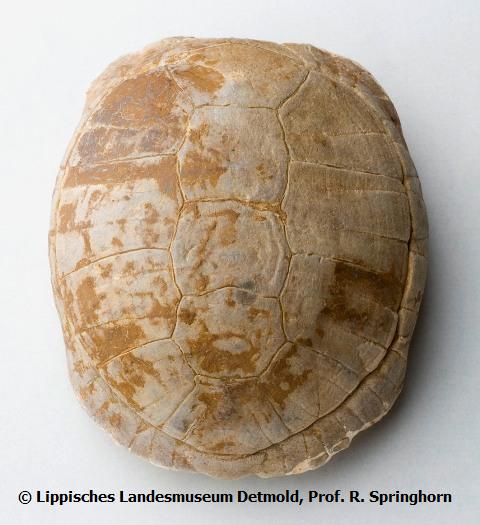 |
| Stylemys nebrascensis, photo © Prof. R. Springhorn. |
Range:
Phylogeny: Testudinidae : Hadrianus + (Testudininae + * : Manouria + (Stylemys + (Gopherus + Hesperotestudo)))
Characters:
Comments: Both morphological and molecular studies recognise this subfamily, but where disagreement arises is regarding primitive representtaives such as the extant Manouria and the Tertiary Stylemys. Morphological cladistic studies (Gaffney & Meylan 1988, Meylan & Sterrer 2000, Gerlach 2001) unambiguously show the Asian species Manouria to be the most basal of the extant Testudinidae, lacking any of the synapomorphies of more derived species. Both also agree that Stylemys is a more advanced form. According to Gaffney & Meylan 1988 Stylemys is a basal member of the subfamily Xerobatinae (best represented by the North American genus Gopherus), wheras analysis by Meylan & Sterrer 2000 recover it as a stem testudinid that predates the Xerobatine-Testudinine split. Wheras, obviously, the genome of a fossil form like Stylemys cannot be tested (although some molecular material may remain in large fossil bones, for example Tyrannosaurus has been confirmed as closer to chickens than crocodiles (ref)), initial molecular sequencing of the family Testudinidae recovered an unexpected sister relationship between Manouria and Gopherus (Le et al 2006). This result was confirmed by later studies on the molecular phylogeny of the testudines as a whole (Thomson & Shaffer 2010, Guillon et al 2012), which would place it in the family Xerobatinae (or Gopherinae, depending on your choice of nomenclature).
Since both explanations cannot be correct, and lacking any combined approach papers to reference, we are faced once again with the choice of which methodology recovers the more reliable phylogenetic signal. If molecular sequencing is more reliable, either Manouria has lost all its advanced features and reverted to an ancestral condition sometime in its evolutionary history, or perhaps more likely the same derived characteristics developed convergently among both in other Xerobatines and the Testudinines. In this latter scenario, Stylemys would be a transitional form between Manouria and the higher Xerobatine. This may not be so unlikely, in view of the hypothesis of Trionychoidea and Kinosternoidea as only very distantly related but as convergent clades. Wheras if parsimony-based cladistic morphology is more reliable, that means the genomic sequences are convergent. MAK130305
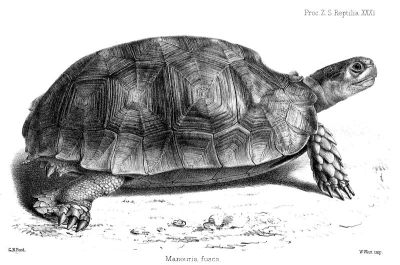 |
| Manouria emys, from Proceedings of the Zoological Society of London 1860, public domain, via Wikipedia |
Range:
Phylogeny: Xerobatinae : (Stylemys + (Gopherus + Hesperotestudo)) + *
Characters:
Comments: Either the most basal living tortoise genus, or the sister taxon of the American gopher tortoise. See Xerobatinae for this morphology vs molecules controversy. This genus has two extant species, the smaller Impressed Tortoise (Manouria impressa) and the larger Asian forest tortoise (Manouria emys), which lives in mountain areas of forest in Southeast Asia in Burma, southern China, Thailand, Laos, Vietnam, Cambodia and Malaysia. Both are endangered, although M. emys is able to breed in captivity. It is the largest tortoise in mainland Asia; a large adult of the northern subspecies, M.e. phayrei, reaches 25 kg in the wild and much more than that in captivity. Even larger was Manouria sondaari - an extinct giant land tortoise from Luzon Island, Philippines. (Wikipedia) MAK130305
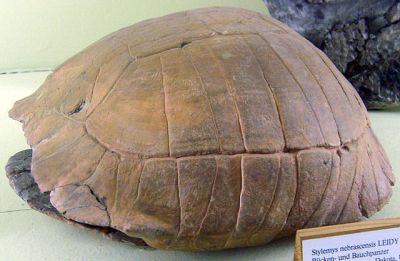 |
| Stylemys nebrascensis shell at the Museum für Naturkunde, Berlin. Photo by FunkMonk, Creative Commons Attribution-Share Alike 3.0 via Wikipedia. |
Stylemys Leidy 1851
Range: Late Eocene to Miocene of Europe, Asia and North America
Phylogeny: Xerobatinae : Manouria + ((Gopherus + Hesperotestudo) + * )
Characters: neural bones hexagonal, with short anterolateral surfaces, nuchal not emarginate, caudal shield undivided (Zittel, Eastman, et al (1932) p.313)
Comments: Stylemys (meaning "pillar mouse") is the first fossil tortoise genus found in the United States (Wikipedia). It is either a primitive member of the subfamily Xerobatinae (Gaffney & Meylan 1988), or a stem testudinid that predates the Xerobatine-Testudinine split (Meylan & Sterrer 2000). Fossils of this genus, especially the type species Stylemys nebrascensis, are very common in the Late Eocene and Oligocene Badlands of Nebraska, South Dakota, and Wyoming, the site of many fossil mammal genera, and it is obvious that these reptiles must have inhabited the ancient landscapes in large numbers. This widespread genus lived in temperate to subtropical areas of North America, Europe, and Asia (for example Stylemys karakolensis is known from the early Tertiary of Turkistan) (Zittel, Eastman, et al 1932 p.313). Fifteen fossil species are listed. The jaw muscles are more primitive than today's tortoises, and the animals would have been herbivorous. While Stylemys species did exhibit the same neck structure as modern tortoises, the forelimbs were unsuitable for burrowing, setting them apart from modern genera. (Wikipedia) MAK130301
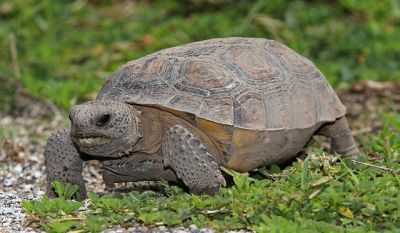 |
| Florida Gopher Tortoise (Gopherus polyphemus), Green Swamp, Florida. Author Creative Commons Attribution 3.0, via Wikipedia |
Range: Oligocene to Recent of North America
Phylogeny: Xerobatinae : Manouria + (Stylemys + (Hesperotestudo + * ))
Comments: Desert living, burrowing tortoises. Gopher tortoises are so named because of their ability to dig large, deep burrows; these can be up to 12 m in length and 3 m deep. The burrows are used by a variety of other species, including mammals, other reptiles, amphibians, and birds (Wikipedia). Gopherus laticunae (Cope 1873) is known from the Oligocene of Colorado, and had a plastron length of about 30 cm. The giant Late Pleistocene Gopherus hexagonatus (Cope 1893) had a plastron length of about 64 cm (Mlynarski, 1976, pp.106-7). There are five extant species that range across the southern United States from California's Mojave Desert across to Florida, and in parts of northern Mexico, and which have a shell of 20-50 cm in length, depending on the species. (Wikipedia). Xerobates is a related genus. MAK130301
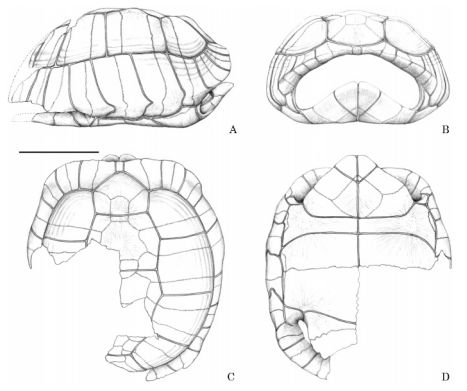 |
| Hesperotestudo bermudae, shell of holotype in A, lateral; B, anterior; C, dorsal; and D, ventral view, from Meylan & Sterrer 2000 fig 1. |
Hesperotestudo Williams, 1950
Range: Pleistocene of southeastern North America and Bermuda
Phylogeny: Xerobatinae : Manouria + (Stylemys + (Gopherus + * ))
Comments: Hesperotestudo is a giant Pleistocene tortoise that lived amongst the megafauna of Pleistoicene North America. Three species are known, a giant species, Hesperotestudo crassicutata, that grew as big as modern day Galapagos Island tortoises, a small species, Hesperotestudo incisa, intermediate in size between H. crassicutata and the gopher tortoise Gopherus polyphemus which was a contemporary found in the same area, and which is still extant, and a large island species, Hesperotestudo bermudae
Originally considered to be aligned to the giant Indo-Pacific island tortoises (Geochelone), cladistic analysis shows it was actually closely related to the North American tortoises (Gopherus) and hence belongs in the family Xerobatinae. Discovery of the island species Hesperotestudo bermudae provides a fifth instance of a testudinid dispersing over open ocean to an oceanic island, which shows that members of this family are well suited to over-water dispersal. (Meylan & Sterrer 2000). It is noteworthy that the unrelated Australasian Pleistocene horned tortoises also included a number of island-living species
The presence of such a large animal, Hesperotestudo crassicutata, which is sensitive to cold, shows that there were no frosts in southern North America during this time. Although it might be argued that these giant tortoises could burrow like its much smaller relative the gopher tortoise, it is hard to see how this could be possible with an animal about three to five times the linear dimensions. MAK130305
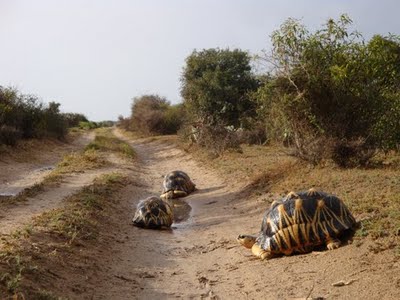 |
| Radiated tortoises Asterochelys radiata photographed in Madagascar by czwg. |
Range: Late Eocene to Recent
Phylogeny: Testudinidae : Hadrianus + (Xerobatinae + * : Testudinini + Megalochelyini)
Characters: (from Gaffney & Meylan 1988): Process of surangular interdigitates with dentary, lower jaw relatively gracile; mental glands absent; medial centrale large, separating distal end of radius from contact with medial proximal carpals. (CKT)
Comments: The Testudininae contains the land tortoises most closely related to the type genus, Testudo, with many species having been referred in the past to either that genus or Geochelone. Among the most famous members of the group are the giant tortoises of the Galapagos and Seychelles islands. (CKT). This group dates back at least to the Late Eocene; Cheirogaster maurini from the Late Eocene of France, and ''Geochelone'' ammon and the Late Eocene or Early Oligocene of Egypt are the eraliest known forms, both characterized by a developed epiplastral lip, a unique synapomorphy of the group (Lourenço et al 2012 p.506). Biogeographic analysis based on molecular phylogeny indicate Africa as the ancestral continental area for the Testudininae (all extant testudinids except Manouria and Gopherus) (Le et al 2006). MAK130307
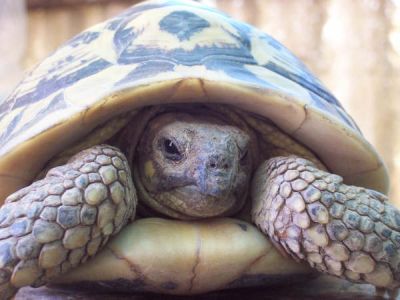 |
| Western Hermann's Tortoise (Testudo hermanni hermanni). Testudo hermanni ranged from the Pleistocene to Recent of Southern Europe (Mlynarski 1976 p.97). Photograph by Bizarria (Wikipedia) |
Phylogeny: Testudininae : Megalochelyini + *
Comments: One of the major groups of testudines discovered through molecular phylogeny (Le et al 2006, Thomson & Shaffer 2010, Guillon et al 2012), which divides the testudinines into two major clades: Indotestudo, Malacochersus, and Testudo; and a diverse assemblage including Aldabrachelys, Chersina, Geochelone, Homopus, Kinixys, Psammobates, and Pyxis. MAK130307
Megalochelyini Giant tortoises and their relatives
Phylogeny: Testudininae : Testudinini + *
Comments: Less apparent morphologically, but discovered via molecular phylogeny (Le et al 2006, Thomson & Shaffer 2010, Guillon et al 2012), this large and diverse assemblage including Aldabrachelys, Chersina, Geochelone, Homopus, Kinixys, Psammobates, and Pyxis. Very impressive are the giant tortoises, such as Geochelone, found on on the remote oceanic islands of the Galapagos and the Seychelles. The largest species, such as the giant Galápagos tortoise Geochelone nigra, can reach 1.5m in length. When first found their carapaces reminding Spanish explorers of a kind of saddle they called a 'galápago', hence the name of the Galapagos islands. Since the archipelago is volcanic in origin and has never been connected to the mainland, they must have reached the islands by rafting, transported by currents that pass up the coast of Chile and Peru before circulating westward (ref). Such Island colonisation has occurred frequently, not only among different testudine lineages but also both in the case of the Australasian meiolaniids and the Caribbean Xerobatine tortoise Hesperotestudo bermudae during the Pleistocene
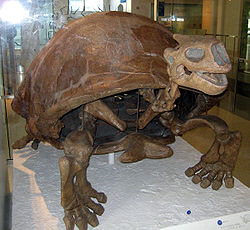 |
| Colossochelys atlas. Photo: Claire Houck , wikipedia |
Both morphology (e.g. Gerlach 2001) and molecular phylogeny (e.g. Le et al 2006) agree that the genus Geochelone as currently defined is polyphyletic, having arisen a number of times from smaller ancestors, presumably through island gigantism. In the past however giant tortoises existed on all continents, beginning with ''Geochelone'' ammon from the Late Eocene or Early Oligocene of Egypt, was a respectably-sized form with a plastron a meter in length. G. richardi (Bergounioux, 1958) from the Oligocene of Catalonia was about the same size. There is no guarantee these early forms belonged in the Megalochelyini crown or even stem group, as to date no comprehensive cladistic analysis has been preformed on these fossil forms. Geochelone grandidieri (Vallant, 1885) from the Pleistocene to Holocene (subfossil) of Madagascar, had a plastron about 2 meters long . G. robusta (Laith-Adams, 1877) from the Pleistocene of Malata was the same size. (Mlynarski 1976 pp.102-106). The largest of all tortoises, the Plio-Pleistocene Colossochelys atlas (Falconer & Cautley, 1844), also known as Testudo atlas and Geochelone atlas was the size of a Volkswagen Beetle. It had a shell length of about 2.1 to 2.5 meters, and an approximate total height of 1.8 meters. Although some weight estimates go as high as 3 to 4 tonnes, a weight of around a tonne is probably more realistic (Paul and Leahy, 1994). In appearance it probably resembled a giant Galápagos tortoise. . During the dry glacial periods it ranged from western India and Pakistan (possibly even as far west as southern and eastern Europe) as far east as Sulawesi and Timor in Indonesia. (Wikipedia). MAK130307
Page last modified MAK130307.
All material by MAK is licensed Creative Commons Attribution License Version 3.0, and may be freely used provided acknowedgement is given. All Wikipedia material is either Gnu Open Source or Creative Commons (see original Wikipedia page for details). Other graphics are copyright their respective owners. Tortoise Resurrection © 2008 Christopher Taylor.